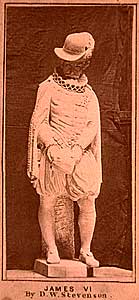 |
James VI
Found on the upper tier of the south-west buttress of the Scott
Monument.
James VI (from the novel 'The Fortunes of Nigel', 1822), is depicted
reading the unexpected petition of George Heriot.
Of the king once called "the wisest fool in Christendom",
Scott wrote:
"He was deeply learned, without possessing useful
knowledge; sagacious in many individual cases, without having real
wisdom… a big and bold assertor of his rights in words, yet
one who tamely saw them trampled on in deeds; a lover of negotiations,
in which he was always outwitted; and one who feared war, where
conquest might have been easy."
Fearful of assassination, he always wears clothes "quilted
so full as to be dagger-proof, which gave him the appearance of
clumsy and ungainly protuberance".
James speaks broad Scots throughout the novel. Of his aversion
to weaponry he says, "There canna be a waur prospective for
a lawfu' king, wha wishes to reign in luve, and die in peace and
honour, than to have naked swords flashing in his een. I am accounted
as brave as maist folks; and yet I profess to ye I could never look
on a bare blade without blinking and winking."
To James also are given the final words of the novel: "And,
my lords and lieges, let us all to our dinner, for the cock-a-leekie
is cooling."
About the Sculptor
David Watson Stevenson (1842 to 1904)
DW Stevenson was born in Ratho, Midlothian on 25 March 1842 and
died in Edinburgh on 18 March 1904. He trained at the Trustees School
and Life School, later also in Rome then worked under William Brodie
for eight years.
While assistant to Sir John Steell, he did statues of ‘Science’,
‘Learning’ and ‘Labour’ for the Scottish
National Memorial to the Prince Consort in Charlotte Square. His
statue of Robert Burns (1898) is in Bernard Street, Leith. Others
include ‘Sir John Steell when sculptor to Her Majesty for
Scotland’ (1887) and ‘Napier of Murchiston’ (1898)
both now in the Scottish National Portrait Gallery.
Also on the Scott Monument, the figures of Queen Mary, Halbert
Glendinning, Charles I, The Fair Maid of Perth, and Montrose.
^ back to the top |



